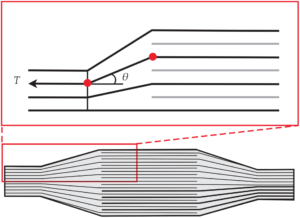It can be tempting in science, and in life, to believe that every stone has already been turned, that the most impactful steps in your field have already been made, that there is nothing left for you to discover. This type of sentiment is often said to have existed (though it was certainly not ubiquitous) in late nineteenth century physics, when people may have felt there was nothing more to be done but the refinement of previous measurements. Of course, the turn of the century shattered any such mindset with the revolutions of quantum mechanics and general relativity.
Even if science does have a good handle on a certain regime of natural behavior, solid work still remains to be done. Even in the most well-trodden fields, there are stones that can be found yet unturned.
A great example of a surprising phenomenon arising from basic rules is that of the phone book trick, which goes something like this: Place two phone books so that they open toward each other and overlap alternating pages from the two books. Now attempt to pull the books apart by their spines. You can’t! In short, it is extremely difficult to pull apart two phone books whose pages have been interleaved. Discovery Channel’s MythBusters gave it a shot and could not pull apart the phone books until they employed the help of a few military tanks.
As it turns out, though squarely in the domain of classical physics, the phone book phenomenon had not been studied in great detail until recently when a few valiant physicists, with resolve to leave no well-trodden scientific stone unturned, sought to dig deeper and give the ol’ phone book trick a proper treatment.
A few surprising results arose from examination of this seemingly simple system, and we’ll discuss one of them here. As you may have guessed, friction is the source of the two phone books’ incredible resistance to separation. But how does that friction arise? Friction is due to a “normal force,” meaning that the direction in which friction acts is perpendicular to the force that initially causes there to be contact between two objects. Just imagine pressing your hand down on a table: You press down, but the resulting friction prevents your hand from moving left or right.
If friction is caused by a perpendicular force than how does friction arise in the phone book trick? After all, you’re pulling on the spines of the books and friction directly opposes your pull — there are no perpendicular, 90˚ forces there, right?

The secret lies in the fanning out of the interleaved pages as they leave the spines of the books. Because the pages are overlapped with those of the other book, they leave their spine at a small angle. Pulling on the spine then pulls on an angled page, like pulling on a rope, and, because of the small angle, that page gets in part pulled downward. This downward action squeezes a page downward, not side-to-side, on top of a neighboring page from the other book and our mysterious side-to-side friction force appears. Now repeat this process for as many pages as are in a phone book, and you’ve got a lot of friction!
Though a familiar concept, friction is a subject worthy of much more scientific study and the physicists behind this phone book trick have taken the time to point out some of the ongoing research on friction in modern science. Check out their full Physical Review Letters publication for more detail.
Peer edited by Joanna Warren.
Follow us on social media and never miss an article: